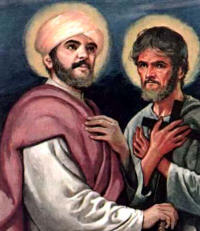
Daily Readings for:May 03, 2014
(Readings on USCCB website)
Collect: O God, who gladden us each year with the feast day of the Apostles Philip and James, grant us, through their prayers, a share in the Passion and Resurrection of your Only Begotten Son, so that we may merit to behold you for eternity. Through our Lord Jesus Christ, your Son, who lives and reigns with you in the unity of the Holy Spirit, one God, for ever and ever.
RECIPES
o Middle Eastern Rice with Black Beans and Chickpeas
ACTIVITIES
o Family and Friends of Jesus Scrapbook Album
o Hymn: Vexilla Regis Prodeunt
o Marian Hymn: Bring Flowers of the Fairest
PRAYERS
o Blessing of Crosses Placed in Fields and Vineyards
o Regina Coeli (Queen of Heaven)
LIBRARY
o James, the Lesser | Pope Benedict XVI
o Philip the Apostle | Pope Benedict XVI
· Easter: May 3rd
· Feast of Sts. Philip and James, apostles
Old Calendar: Saints Alexander I, pope; Eventius and Theodulus, martyrs and Juvenal, bishop and confessor; Finding of the Holy Cross; (Hist)
Today's Mass tells us that the example of the Apostles is the most certain and direct path to heaven. They suffered and were persecuted, but they placed their confidence in God and now they rejoice in heaven. We too must have confidence in God and not be troubled in our adversities. In our Father's house there are many mansions, and if we follow the way indicated by Him, Christ will come at the end of our life and take us to Himself.
Before the reform of the General Roman Calendar the Feast of Sts. Philip and James was celebrated on May 11 and the Finding of the Holy Cross and the commemoration of Sts. Alexander I, Eventius and Theodulus and St. Juvenal were celebrated. None of these feasts remain on the calendar in the United States.
St. Philip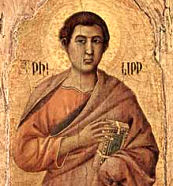
The Apostle Philip was one of Christ's first disciples, called soon after his Master's baptism in the Jordan. The fourth Gospel gives the following detail: "The next day Jesus was about to leave for Galilee, and He found Philip. And Jesus said to him: Follow Me. Now Philip was from Bethsaida, the town of Andrew and Peter. Philip found Nathanael, and said to him: We have found Him of whom Moses in the Law and the Prophets wrote, Jesus the Son of Joseph of Nazareth. And Nathanael said to him: Can anything good come out of Nazareth? Philip said to him: Come and see" (John 1:43ff). — The Church's Year of Grace, Pius Parsch
Patron: Hatters; Luxembourg; pastry chefs; Uruguay.
Symbols: basket; basket and Tau cross or letter Tau; two or three loaves and a cross; patriarchal cross and spear; knotted cross; broken idols; inverted cross; tall column; dragon; carpenter's square and cross; long staff and spear; tall cross and book.
Often Portrayed As: Elderly bearded man holding a basket of loaves and a cross which is often t-shaped; elderly man casting a devil from the idol of Mars; elderly man crucified on a tall cross; elderly man holding loaves and fishes; elderly man with a dragon nearby; elderly man with a loaf and book; elderly man with a snake nearby; loaves of bread; man baptizing the Ethiopian eunuch; man holding a book or scroll reading descendit ad inferna; with Saint Andrew.
St. James the Less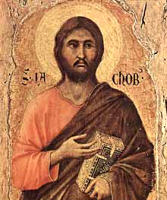
St. James the Less, a brother of the Apostle Jude, was of Cana of Galilee. He is the author of one of the Catholic Epistles in the New Testament. He was favored by an appearance of the Risen Christ (I Cor. 15:7). After the dispersion of the Apostles he was made Bishop of Jerusalem. He was visited by St. Paul (Gal. 1:19). He spoke after Peter at the meeting of the Apostles (Acts 15:13). When he refused to deny the Divinity of Christ, the Jews cast him down from the terrace of the temple and clubbed him to death. The Breviary contains a very moving description of his death. "When he was ninety-six years old and had governed the Church for thirty years in a most holy manner, the Jews sought to stone him, then took him to the pinnacle of the temple and cast him off headlong. As he lay there half dead, with legs broken by the fall, he lifted his hands toward heaven and prayed to God for the salvation of his enemies, saying: Lord, forgive them for they know not what they do! While the apostle was still praying, a fuller struck his head a mortal blow." His relics now rest next to those of St. Philip in the church of the Holy Apostles in Rome, and their names are mentioned in the first list in the Canon of the Mass.
Excerpted from The Church's Year of Grace, Pius Parsch
Patron: Apothecaries, druggists, dying people, fullers, hatmakers, hatters, milliners, pharmacists, Uruguay.
Symbols: Vertical saw; Fuller's club; windmill; halbert; three stones; loaf of bread.
Often portrayed as: man holding a book.
Things to Do:
- Read the Epistle of St. James, a book that is devout and edifying as well as highly practical.
- St. James is referred to as "the brother of Jesus", learn how to prove that Mary did not have any other children but remained ever a virgin.
The Finding of the Holy Cross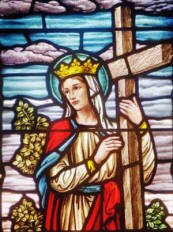
After the victory Constantine gained through the power of the Cross which he had seen in the heavens, and whose sign he reproduced in the Labarum, St. Helena, his mother, went to Jerusalem to try to find the true Cross. At the beginning of the second century, Hadrian had Calvary and the Holy Sepulchre covered over with earth, the top of which became a terrace of 100 feet in length, where were erected a statue of Jupiter and a temple of Venus. The Empress had them razed to the ground, and dug up. The laborers found the nails and three crosses. The miraculous cure of a woman authenticated the sacred tree, to which we owe "life, salvation and resurrection".
St. Helena divided the precious wood in three. One part was deposited in Rome in the church of Holy Cross in Jerusalem. The second in Constantinople and the third in Jerusalem. This last relic having been carried off by the Persians and recovered by Heraclius, this emperor solemnly brought it back to Jerusalem on May 3rd, 628.
Excerpted from Saint Andrew Daily Missal
Sts. Alexander I , Eventius and Theodulus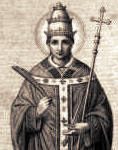
Alexander governed the Church under the Emperor Hadrian. His name is inscribed in the Canon of the Mass. He was martyred at the same time as the priests Eventius and Theodulus, in 117, and their bodies rest in Rome, in the church of St. Sabina, where the Station is held on Ash Wednesday. — Saint Andrew Daily Missal
Symbols: Nailes; stiletto; angel with torch; Often pictured with his chest pierced with nails or spikes.
St. Juvenal A priest and physician from the East, he immigrated to Narni, Italy, and was named first bishop of that See by Pope Damasus. Juvenal is reported to have saved Narni from destruction by invading Ligurians and Sarmatians when thousands of the invaders were drowned in a downpour reputedly brought on by his prayers. He was noted for his eloquent preaching, which converted many, and is the patron of Narni. — Dictionary of Saints, John J. Delaney
A priest and physician from the East, he immigrated to Narni, Italy, and was named first bishop of that See by Pope Damasus. Juvenal is reported to have saved Narni from destruction by invading Ligurians and Sarmatians when thousands of the invaders were drowned in a downpour reputedly brought on by his prayers. He was noted for his eloquent preaching, which converted many, and is the patron of Narni. — Dictionary of Saints, John J. Delaney